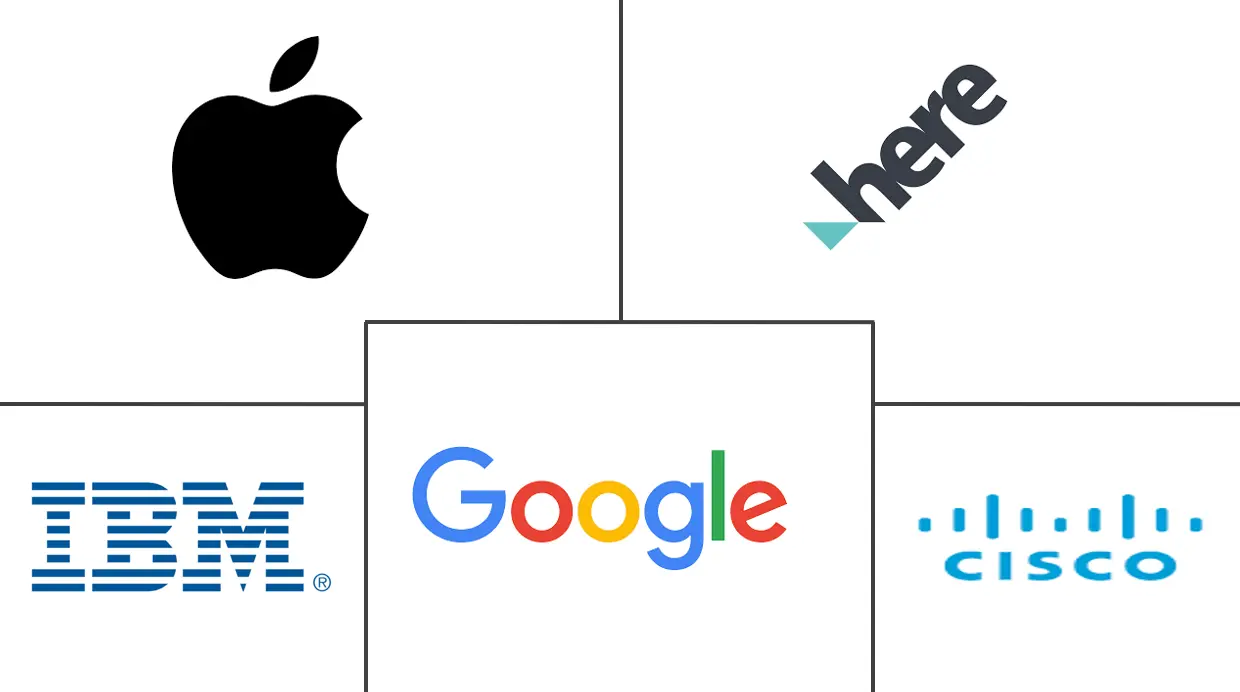Location Based Services Market Size and Share
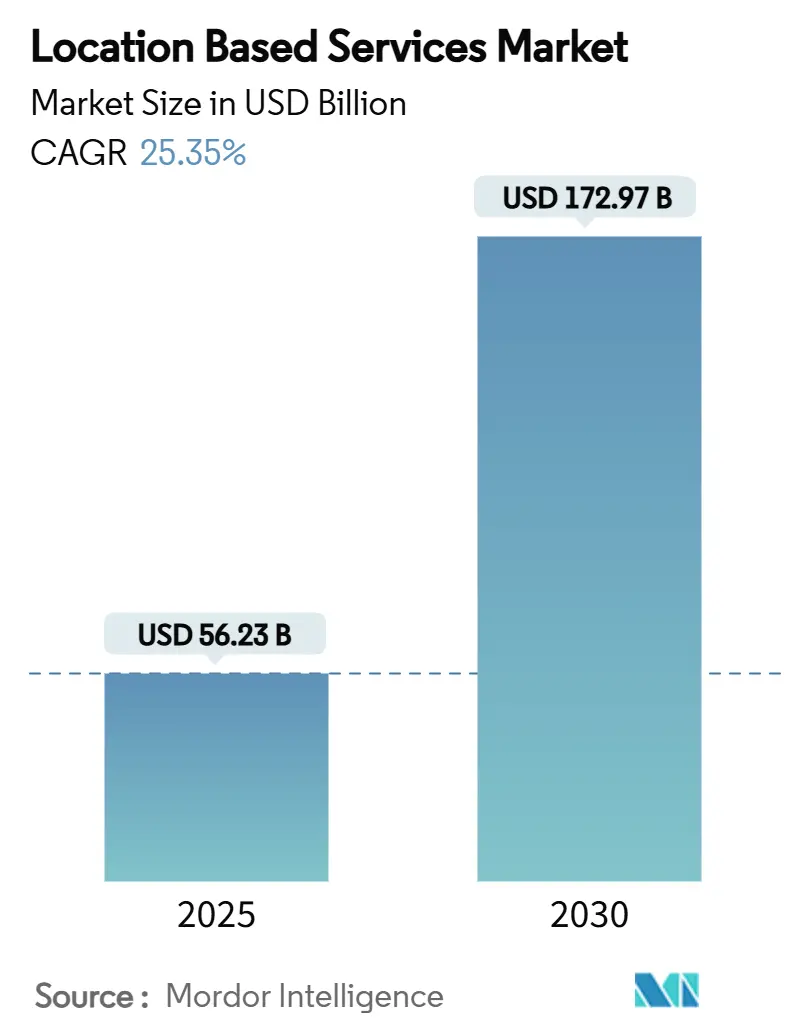
Location Based Services Market Analysis by Mordor Intelligence
The location-based services market size equals USD 56.23 billion in 2025 and is forecast to advance at a 25.35% CAGR, reaching USD 172.97 billion by 2030. This brisk trajectory stems from 5G network-slicing deployments that guarantee sub-meter accuracy, mandatory emergency-call regulations that enforce Advanced Mobile Location, and the rise of digital-twin logistics hubs that depend on real-time location systems. Intensifying hyper-local advertising budgets, centimeter-grade satellite augmentation, and AI-driven indoor positioning all expand addressable use cases, prompting enterprises to embed location intelligence across marketing, safety, and industrial automation workflows. Market participants therefore focus on multi-modal positioning engines that blend GPS, UWB, BLE, Wi-Fi FTM, and sensor fusion to deliver seamless indoor-outdoor coverage. Mergers, high-value partnerships, and compliance spending drive consolidation, while privacy regulation shapes commercial models toward explicit-consent engagement.
Key Report Takeaways
- By component, services held 47.5% of location-based services market share in 2024; software is forecast to post a 26.8% CAGR through 2030.
- By location type, outdoor applications accounted for 68.6% of the location-based services market size in 2024, whereas indoor positioning is projected to climb at a 28.6% CAGR to 2030.
- By core technology, GPS/A-GPS commanded 47.5% of the location-based services market share in 2024; UWB is forecast to post a 27.9% CAGR through 2030.
- By application, Navigation and Mapping commanded 23.2% of 2024 revenue, while Location-Based Advertising and Promotion is pacing the fastest at a 28.7% CAGR through 2030.
- By end-user industry, Transportation and Logistics held 22.7% share in 2024; healthcare and life sciences recorded the highest growth outlook at 26.5% CAGR between 2025 and 2030.
- By geography, North America commanded 36.8% of 2024 revenue, while Asia-Pacific is pacing the fastest at a 25.8% CAGR through 2030.
Global Location Based Services Market Trends and Insights
Drivers Impact Analysis
| Driver | (~) % Impact on CAGR Forecast | Geographic Relevance | Impact Timeline |
|---|---|---|---|
| Explosion of hyper-local advertising budgets | +4.2% | Global, with North America leading | Medium term (2-4 years) |
| Mandates for e-911 and AML emergency accuracy in OECD markets | +3.8% | OECD countries, EU mandatory since 2022 | Short term (≤ 2 years) |
| Rise of indoor positioning via BLE, UWB and sensor fusion | 5.1% | Global, concentrated in urban centers | Medium term (2-4 years) |
| 5G network slicing enabling sub-meter latency LBS | 4.7% | Asia-Pacific core, spill-over to North America and EU | Long term (≥ 4 years) |
| Proliferation of 'digital twin' logistics hubs needing RTLS | 3.9% | Global, industrial clusters priority | Medium term (2-4 years) |
| Satellite-based augmentation (SBAS, multi-GNSS) for cm-grade precision | 3.8% | Global, aviation and agriculture focus | Long term (≥ 4 years) |
| Source: Mordor Intelligence | |||
Explosion of hyper-local advertising budgets
Marketers plan to allocate 20%-plus of budgets to local campaigns in 2025, up from 46% in 2024, as geofencing proves effective for foot-traffic uplift. Google Maps already monetizes USD 11.1 billion annually through ad placements. Retailers adopting location-triggered push notifications report sharp increases in in-store conversions, validating the revenue-expansion thesis. Greater location granularity also supports dynamic creative optimization, letting brands tailor messages to micro-markets. As a result, the location-based services market gains sustained demand from advertising technology platforms, publishers, and brands eager to link online intent with offline purchase paths.
Mandates for e-911 and AML emergency accuracy in OECD markets
The European Electronic Communications Code requires AML on all smartphones, delivering caller coordinates within 50 m for 87% of emergencies [1]ETSI, “Advanced Mobile Location Standard Now Mandatory on All European Smartphones for Emergency Calls,” etsi.org. The UK experience shows a 4,000-fold accuracy boost versus Cell-ID, cutting response times and potentially saving 7,500 lives over 10 years. More than 30 nations have adopted AML, while the US is tightening E-911 vertical-accuracy rules. Telcos must therefore upgrade positioning cores and hand-off APIs, fueling spending on hybrid GNSS, Wi-Fi, and sensor-assisted solutions. Compliance budgets directly expand the location-based services market as operators embed advanced location middleware within network cores and end-user apps.
Rise of Indoor Positioning via BLE, UWB and Sensor Fusion
UWB achieves sub-30 cm accuracy in 95% of industrial trials through time-of-arrival and angle-of-arrival techniques. BLE beacons deliver 92.7% dynamic floor-level precision in multi-story atria. Combining Wi-Fi FTM, UWB, and inertial sensors further suppresses drift, ensuring reliable navigation inside hospitals, airports, and factories. Hospitals deploying RTLS solutions cut search time for wheelchairs and beds, improving patient throughput, as demonstrated at Oulu University Hospital. These results illustrate why indoor accuracy advances are central to unlocking asset-tracking, way-finding, and AR-commerce opportunities across the location-based services market.
5G Network Slicing Enabling Sub-meter Latency LBS
3GPP Release 18 introduces bandwidth aggregation and carrier-phase analytics, enabling sub-meter outdoor positioning [2] Ericsson, “5G Advanced Positioning in 3GPP Release 18,” ericsson.com. Network slices grant guaranteed latency and QoS for mission-critical localization, such as autonomous drones and remote surgery. Demonstrations in commercial standalone 5G networks show indoor accuracies of 2-3 m when fused with BIM data. Operators see a USD 100 billion healthcare revenue pool tied to 5G location services by 2026. These capabilities encourage industrial enterprises to procure slice-backed RTLS, amplifying demand within the location-based services market.
Restraints Impact Analysis
| Restraint | (~) % Impact on CAGR Forecast | Geographic Relevance | Impact Timeline |
|---|---|---|---|
| Heightened consumer push-back on location privacy | -2.8% | Global, strongest in EU and California | Short term (≤ 2 years) |
| Regulatory fragmentation (GDPR, CCPA, India DPDP Act) | -3.2% | Global, varying compliance requirements | Medium term (2-4 years) |
| Indoor mapping standardisation lag increases integration cost | -2.1% | Global, concentrated in urban centers | Medium term (2-4 years) |
| RF-signal multipath and interference in dense urban cores | -1.9% | Global, metropolitan areas priority | Long term (≥ 4 years) |
| Source: Mordor Intelligence | |||
Heightened consumer push-back on location privacy
Surveys show 71% of users will only share location after explicit consent. GDPR mandates data-minimization, while CCPA imposes opt-out mechanics, reducing always-on tracking coverage by up to 30%. India’s DPDP Act introduces extra consent layers, compelling providers to invest in differential-privacy and federated-learning models that add engineering cost. These shifts slow data-collection velocity, tempering certain advertising revenue streams inside the location-based services market.
Regulatory fragmentation (GDPR, CCPA, India DPDP Act)
Cross-border data-transfer constraints require localized data centers, inflating infrastructure bills by 15-25% for multi-region operators. Conflicting rules—GDPR’s erasure right versus CCPA portability—drive parallel compliance stacks that drain 20-30% of developer bandwidth. Smaller vendors face disproportionate cost burdens, encouraging acquisitions by capital-rich incumbents. The compliance drag therefore modestly suppresses the CAGR of the location-based services market.
Segment Analysis
By Component: Services Propel Adoption
Services represented 47.5% of 2024 revenue as enterprises outsourced design, deployment, and support to managed-service experts. Software, however, is forecast to log a 26.8% CAGR, underscoring how AI analytics convert raw pings into business actions. Large 3PLs integrating digital-twin command centers illustrate why turnkey suites attract premium subscriptions. Meanwhile, hardware growth stays positive as UWB anchors and BLE gateways proliferate in healthcare campuses.
The location-based services market size for software subscriptions climbs steadily as Mapbox’s MapGPT and TomTom’s Azure integrations let automakers push over-the-air upgrades without refreshing on-board units. Service integrators bundle hardware, cloud dashboards, and analytics, ensuring lower total cost of ownership for clients and reinforcing recurring-revenue visibility.
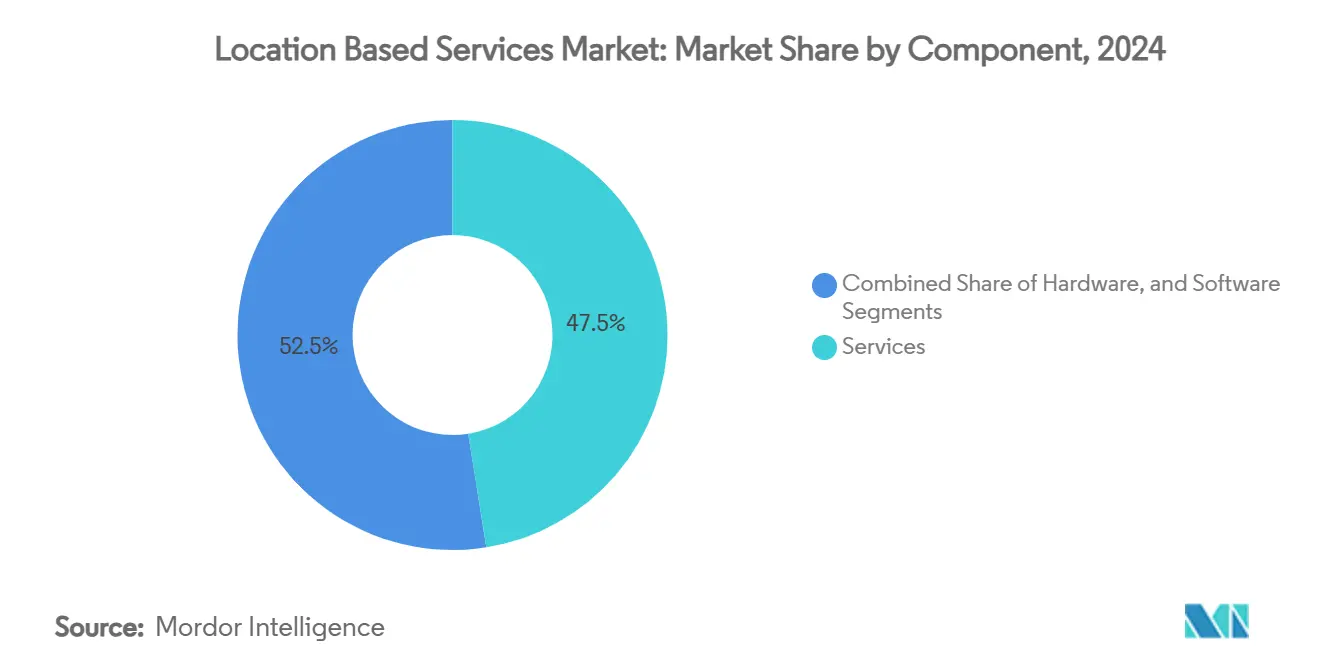
Note: Segment shares of all individual segments available upon report purchase
By Location Type: Indoor Momentum Builds
Outdoor positioning still dominates owing to mature GNSS ecosystems, yet indoor deployments are scaling fast. The location-based services market share for outdoor stood at 68.6% in 2024; indoor positioning is tracking a 28.6% CAGR through 2030, suggesting convergence down the line. Hospitals, malls, and airports deploy BLE and UWB tags to cut asset-search cycles and guide visitors, inching the indoor slice toward parity with outdoor during the forecast horizon.
Hybrid solutions hand-off seamlessly between GPS, 5G, Wi-Fi, and Bluetooth, preserving user experience. Standardisation consortia continue refining accuracy benchmarks, which should trim calibration costs and unlock pent-up demand, expanding the overall location-based services market.
By Core Technology: UWB Ascends
GPS/A-GPS commanded 25.5% of 2024 value; Ultra-Wideband is the fastest mover at 27.9% CAGR thanks to centimeter-level accuracy that suits robotics, warehousing, and secure-access applications. Wi-Fi FTM remains popular for cost-effective indoor fixes, while BLE gains uptake in energy-sensitive devices. 5G Advanced positioning will further compress error margins, challenging satellite reliance in urban cores and propelling multi-sensor fusion sales within the location-based services market.
RFID and NFC technologies serve specialized applications in asset tracking and contactless interactions, particularly in logistics and retail environments where short-range positioning suffices for inventory management and customer engagement. The convergence of multiple positioning technologies creates hybrid solutions that optimize accuracy and reliability across different use cases, with sensor fusion techniques combining Wi-Fi Fine Time Measurement (FTM), UWB, and Inertial Measurement Units (IMU) to reduce positioning errors through maximum likelihood estimation
By Application: Advertising Overtakes Navigation
Navigation and mapping retained the largest absolute revenue at 23.2% in 2024, yet location-based advertising and promotions sprint ahead at 28.7% CAGR as retailers pivot toward location-triggered offers. Asset-tracking remains essential for logistics compliance. Emergency services modules enjoy stable demand under AML mandates, while gaming and AR unlock new monetization after landmark deals such as the USD 3.5 billion Niantic acquisition.
Social media and engagement platforms increasingly integrate location features to enhance user experiences and enable targeted content delivery, while the convergence of artificial intelligence and location services creates new application categories that combine real-time positioning with predictive analytics. The shift toward contextual location services reflects changing user expectations for privacy-preserving applications that activate location features only when explicitly requested, rather than continuous background tracking that raises privacy concerns.
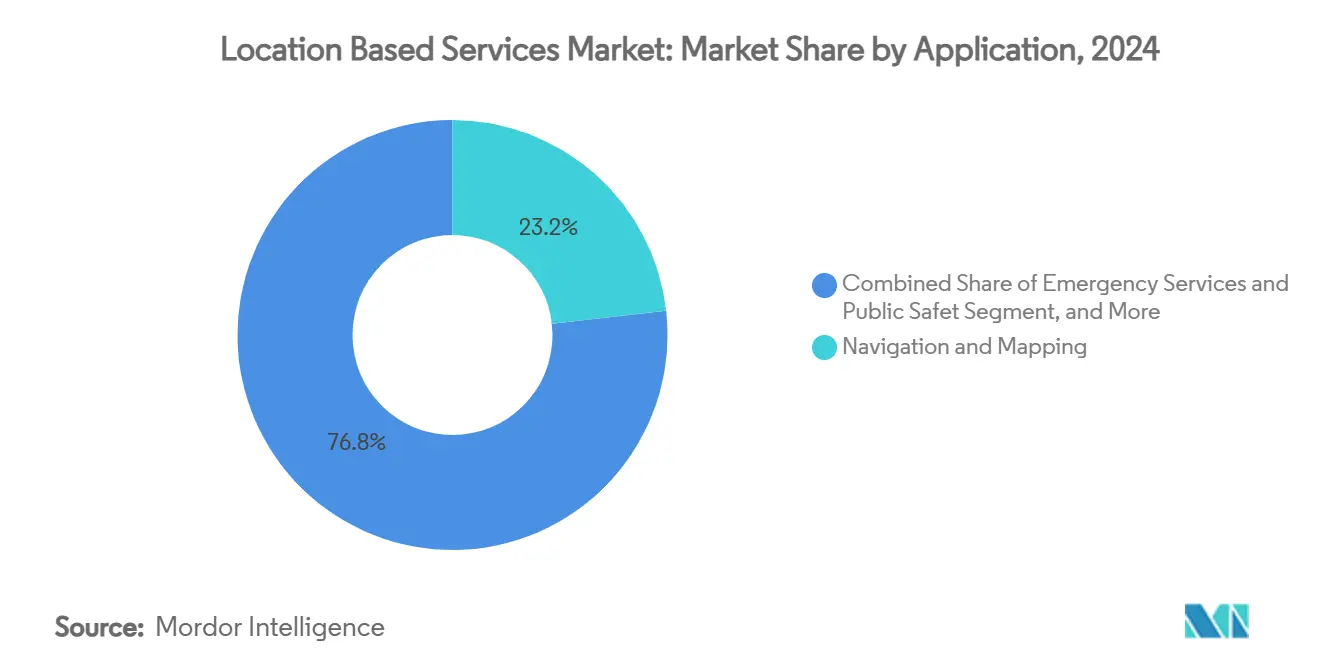
Note: Segment shares of all individual segments available upon report purchase
By End-user Industry: Healthcare Leads Growth
Transportation and logistics accounted for 22.7% of 2024 turnover, but healthcare is scaling fastest at 26.5% CAGR as hospitals invest in patient flow optimisation and asset safety. Retail leverages geofencing to cut card-false-decline rates by 30%. Manufacturing taps private 5G RTLS for automated guided vehicles, while government agencies embed AML for public safety, reinforcing cross-sector revenue diversity inside the location-based services market.
Manufacturing and industrial applications benefit from private 5G networks that enable precise asset tracking and automation, while telecom and IT services sectors integrate location capabilities into network optimization and customer service applications.
Geography Analysis
North America generated the largest slice at 36.8% in 2024 on the back of AML-ready smartphone penetration and robust cloud infrastructure. High-value contracts such as HERE Technologies’ USD 1 billion AWS alliance illustrate the region’s scale. Federal E-911 deadlines ensure continuous operator investment, while automotive OEMs trial lane-level HD maps for Level-3 autonomy.
Asia-Pacific is the fastest-growing at 25.8% CAGR, with unique mobile subscribers on track to hit 2.1 billion by 2030 and contribute USD 880 billion to GDP [3]GSMA, “Mobile Economy Asia Pacific 2024,” gsma.com. Standalone 5G rollouts in China, Korea, and Japan foster network-based positioning APIs; SBAS constellations such as GAGAN complement GNSS for precision farming. Governments champion data-governance frameworks that balance innovation with privacy, encouraging domestic ecosystem formation and enlarging the location-based services market size across the region.
Europe maintains steady momentum through stringent privacy leadership that nurtures consumer trust. AML has been mandatory on all smartphones since 2022, catalyzing backend upgrades among carriers and PSAPs. An emerging crop of privacy-focused startups employs differential-privacy to meet GDPR, enriching service diversity. Southern and Eastern European cities trial U-Space corridors requiring reliable drone positioning, adding a new adjacency.South America and Middle East and Africa remain nascent but promising. Brazil adopts SBAS for aviation, while Gulf smart-city programs deploy BLE m-commerce beacons in mega-malls. African regional aviation bodies collaborate on SatNav-Africa SBAS, sowing foundational infrastructure for future precision-agriculture and transport services. Collectively these initiatives broaden the geographic footprint of the location-based services market.
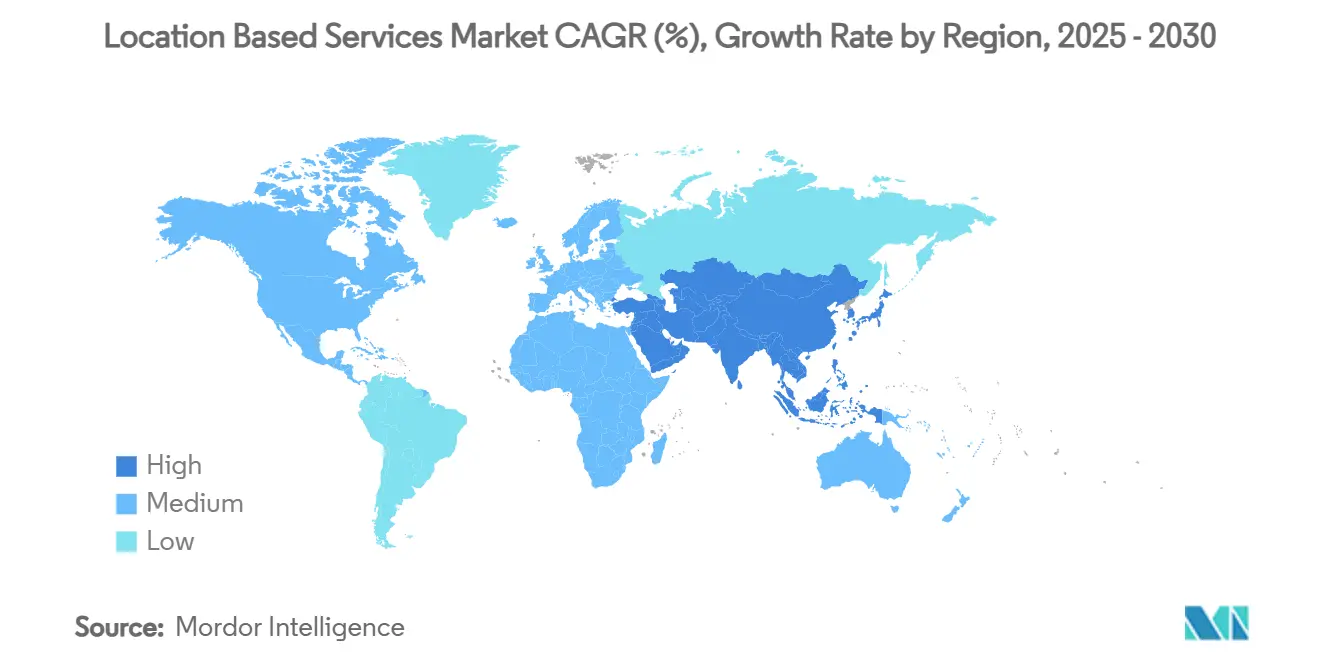
Competitive Landscape
The location-based services market features moderate concentration. Platform giants Google, Apple, and Microsoft bundle mapping SDKs into OS ecosystems, securing default positioning channels. Specialized firms HERE, TomTom, and Mapbox compete on neutral-platform HD maps and developer tooling. Strategic alliances dominate: HERE’s USD 1 billion AWS pact scales AI streaming maps; TomTom renews Azure Maps integration through 2030; Mapbox pairs with Hyundai AutoEver for immersive 3D navigation in next-generation infotainment.
M&A accelerates: Powerfleet bought Fleet Complete for USD 200 million to deepen telematics, Viavi acquired Spirent for USD 1.3 billion to boost PNT test capabilities, and LocationMind purchased Irys for US expansion. Patent filings cover hybrid GNSS-cellular positioning with transactional overlays, underscoring IP differentiation.
Indoor-position leaders IndoorAtlas, Sewio Networks, and Pointr harness magnetic-field mapping and UWB to challenge outdoor incumbents. Startups focusing on privacy-preserving analytics gain traction amid tightening regulation, while chip vendors including Qualcomm and Silicon Labs embed low-power ranging engines into IoT SoCs.
Location Based Services Industry Leaders
-
Google LLC (Alphabet Inc.)
-
Apple Inc.
-
Cisco Systems, Inc.
-
IBM Corporation
-
HERE Global B.V.
- *Disclaimer: Major Players sorted in no particular order
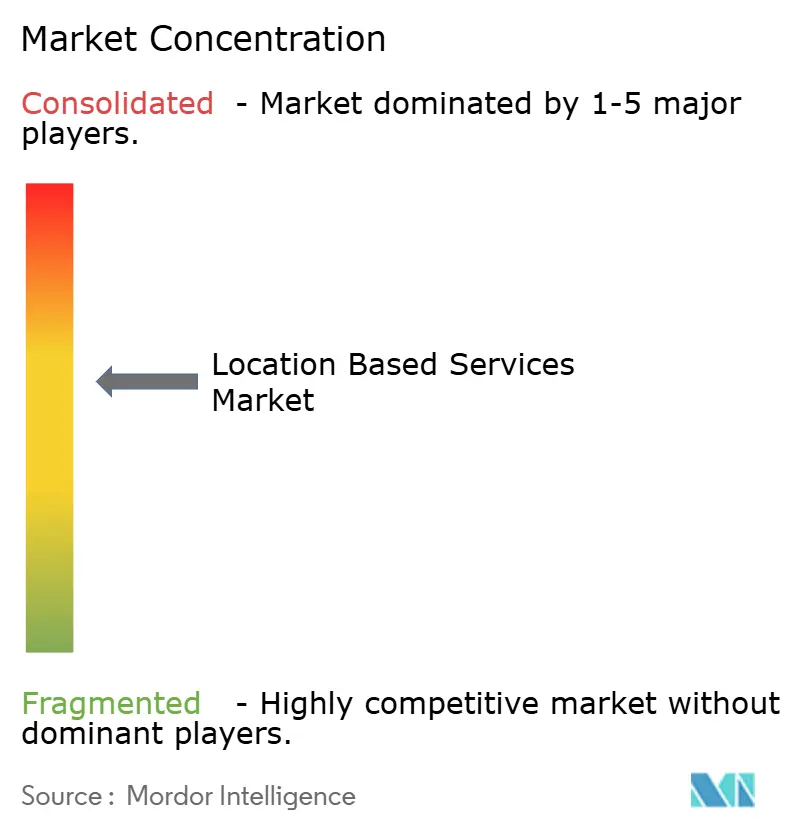
Recent Industry Developments
- July 2025: Uber partnered with Baidu to deploy driverless vehicles globally, leveraging Apollo Go’s 11 million-ride track record.
- January 2025: Mapbox and Hyundai AutoEver showcased AI-driven 3D navigation plus MapGPT voice assistance at CES 2025.
- January 2025: Qualcomm announced the next evolution of Qualcomm Aware™, enabling asset observability and location telemetry across logistics, retail, and energy sectors.
- January 2025: HERE Technologies unveiled a USD 1 billion collaboration with AWS to deliver AI-powered live-streaming maps aimed at automating enterprise workflows.
Global Location Based Services Market Report Scope
Location-based services (LBSs) are computer or mobile applications that provide information based on the location of the device and the user, primarily through mobile portable devices, such as smartphones and mobile networks.
The precision of the location services primarily depends on the hardware and software used in the mobile communication system, along with the positioning server. The Location-based Services Market is segmented by Location (Indoor, Outdoor), Service Type (Professional, Managed), End-user Industry (FMCG, Retail, Healthcare, IT and Telecom, and Transportation), and Geography(North America(United States and Canada), Europe(United Kingdom, Germany, and France), Asia-Pacific(China, Japan, and India).
The market sizes and forecasts are provided in terms of value (USD million) for all the above segments.
| Hardware |
| Software |
| Services |
| Indoor |
| Outdoor |
| GPS / A-GPS |
| Wi-Fi and WLAN Triangulation |
| Bluetooth Low Energy (BLE) |
| Ultra-Wideband (UWB) |
| RFID and NFC |
| Navigation and Mapping |
| Location-Based Advertising and Promotion |
| Asset and Fleet Tracking |
| Emergency Services and Public Safety |
| Gaming and Augmented Reality |
| Social Media and Engagement |
| Retail and FMCG |
| Transportation and Logistics |
| Healthcare and Life Sciences |
| Telecom and IT Services |
| Oil, Gas and Energy |
| Government and Public Sector |
| Manufacturing and Industrial |
| North America | United States | |
| Canada | ||
| Mexico | ||
| South America | Brazil | |
| Argentina | ||
| Rest of South America | ||
| Europe | Germany | |
| United Kingdom | ||
| France | ||
| Italy | ||
| Spain | ||
| Russia | ||
| Rest of Europe | ||
| Asia-Pacific | China | |
| Japan | ||
| India | ||
| South Korea | ||
| Australia and New Zealand | ||
| Rest of Asia-Pacific | ||
| Middle East and Africa | Middle East | Saudi Arabia |
| United Arab Emirates | ||
| Turkey | ||
| Rest of Middle East | ||
| Africa | South Africa | |
| Nigeria | ||
| Egypt | ||
| Rest of Africa | ||
| By Component | Hardware | ||
| Software | |||
| Services | |||
| By Location Type | Indoor | ||
| Outdoor | |||
| By Core Technology | GPS / A-GPS | ||
| Wi-Fi and WLAN Triangulation | |||
| Bluetooth Low Energy (BLE) | |||
| Ultra-Wideband (UWB) | |||
| RFID and NFC | |||
| By Application | Navigation and Mapping | ||
| Location-Based Advertising and Promotion | |||
| Asset and Fleet Tracking | |||
| Emergency Services and Public Safety | |||
| Gaming and Augmented Reality | |||
| Social Media and Engagement | |||
| By End-user Industry | Retail and FMCG | ||
| Transportation and Logistics | |||
| Healthcare and Life Sciences | |||
| Telecom and IT Services | |||
| Oil, Gas and Energy | |||
| Government and Public Sector | |||
| Manufacturing and Industrial | |||
| By Geography | North America | United States | |
| Canada | |||
| Mexico | |||
| South America | Brazil | ||
| Argentina | |||
| Rest of South America | |||
| Europe | Germany | ||
| United Kingdom | |||
| France | |||
| Italy | |||
| Spain | |||
| Russia | |||
| Rest of Europe | |||
| Asia-Pacific | China | ||
| Japan | |||
| India | |||
| South Korea | |||
| Australia and New Zealand | |||
| Rest of Asia-Pacific | |||
| Middle East and Africa | Middle East | Saudi Arabia | |
| United Arab Emirates | |||
| Turkey | |||
| Rest of Middle East | |||
| Africa | South Africa | ||
| Nigeria | |||
| Egypt | |||
| Rest of Africa | |||
Key Questions Answered in the Report
What is driving the rapid expansion of the location-based services market?
Growth stems from 5G positioning accuracy, AML emergency mandates, and rising hyper-local advertising budgets, pushing the market toward a 25.35% CAGR to 2030.
Which segment of the location-based services market is growing fastest?
Indoor positioning is projected to rise at a 28.6% CAGR as BLE and UWB deliver sub-meter accuracy inside hospitals, malls, and factories.
How large is the location-based services market size for software solutions?
Software revenue is expected to climb sharply within overall market size, aided by AI analytics that transform raw pings into actionable intelligence.
Why is Asia-Pacific considered the most promising geography?
Standalone 5G rollouts, SBAS initiatives, and a forecast 2.1 billion mobile-subscriber base fuel a 25.8% CAGR, the highest globally.
Page last updated on:
